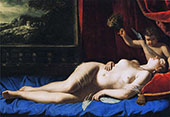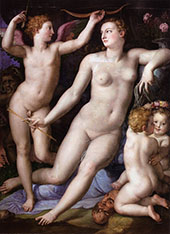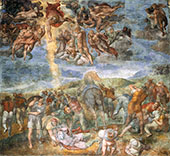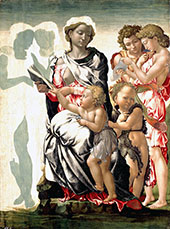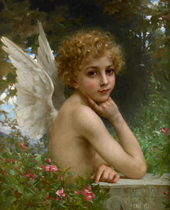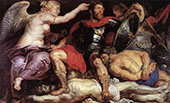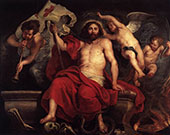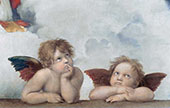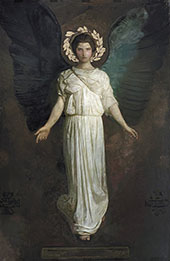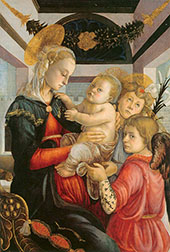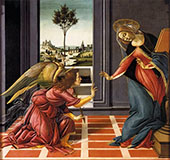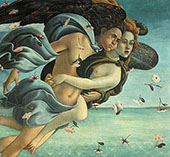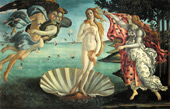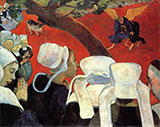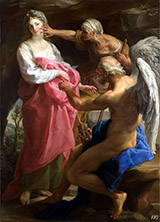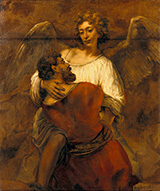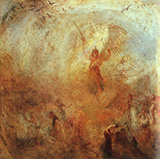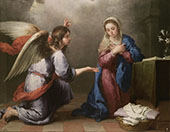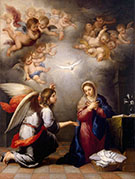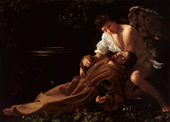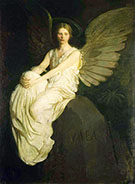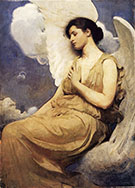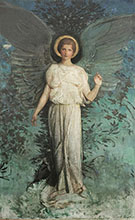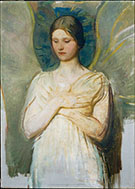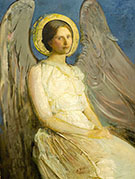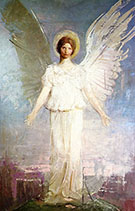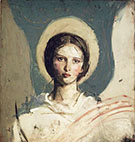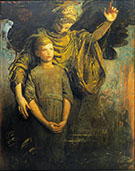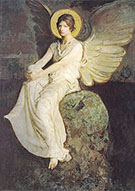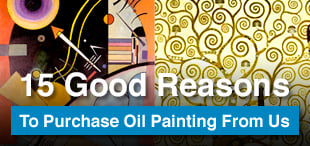Famous Angel replica paintings on Canvas for sale
Buy famous angel reproduction oil paintings
Angels were first depicted in art from the third century onwards. From this moment, angels in paintings have subsequently remained enduringly popular, gracing art and the popular imagination with their ethereal presence.
Usually depicted as beautiful and serene, they can also range from awe-inspiring and frightening creatures right through to cute cherubim with chubby cheeks and innocent faces.
Some of the greatest paintings in history depict angels. From the Italian Renaissance to the Dutch Golden Age and modern contemporary art, it’s a topic that enthralls painters and the art loving public alike.
To mark this unique art historical phenomenon, here’s your guide to some of the most famous angel paintings ever created.
Our Most Famous Angel Paintings: A Timeline
Artistic depictions of angels have incredibly early origins. As well as appearing in Medieval Illuminated manuscripts and Byzantine art, some of the earliest angles in paintings were found in the “Catacomb of Priscilla”. A Christian burial site dating to the third century in Rome, this unique archaeological site contains numerous religious frescos narrating Biblical passages.
This rich tradition subsequently continued through the centuries, with Renaissance angel paintings becoming some of the most recognizable images of religious art. Unlike medieval portrayals however, Renaissance angels began appearing in more humanized and realistic forms.
This progression accompanied the concurrent shift towards naturalism with the High Renaissance, evidenced in the art of the great masters such as Raphael, Leonardo da Vinci and Caravaggio.
To provide a brief introduction to famous angel paintings, we’ve compiled a timeline of some of our most popular angel oil painting reproductions…
Sandro Botticelli, The Angel of the Annunciation (1481)
In this early renaissance Renaissance painting of agenls, the Annunciation (referencing Angel Gabriel’s announcement to the Virgin Mary of her impending motherhood) is set within a contemporary Italian Renaissance palace.
As well as a beautiful example of religious art in its own right, Botticelli’s artwork offers fascinating glimpses into popular furnishings. For instance, Mary kneels on a particularly beautiful and intricate carpet.
It’s also full of symbolism, with elements such as the walled garden symbolizing Mary’s purity. The heavenly realm on the right (full of worldly possessions) further contrasts with the angelic, serene messenger on the left.
Michelangelo, The Creation of Adam (c.1512)
Forming part of the Sistine Chapel ceiling, Michelangelo’s The Creation of Adam illustrates the Biblical creation narrative. God thus breathes life into Adam, surrounded by a whole host of angelic forms.
Despite the clear narrative, debates rage as to the identity of these twelve figures.
Some argue they represent Eve and the entirety of the human race. Conversely, others believe the Virgin Mary appears beside God. Yet more alternative interpretations simply posit a group of heavenly beings. Perhaps it’s an art historical debate destined to remain a mystery…
Raphael, The Sistine Madonna (c.1513)
Amongst Renaissance cherub paintings, Raphael’s curious (or perhaps bored) putti are some of the most recognizable images of angels of all time.
Commissioned by Pope Julius II, Raphael angels represents the Virgin Mary cradling the baby Jesus. Underneath however, are two innocent yet intriguing putti.
Represented as roughly the same age as Jesus, the cherubs have tousled hair, feathered wings and adorable chubby physiques. Although their identity remains a mystery, they could be the children of Raphael’s model for the Virgin Mary.
Agnolo Bronzino, Venus, Cupid and Envy (1548)
As one of Bronzino’s most enigmatic and complex cupid art, this “angel” painting actually represents the goddess Venus. She gazes provocatively towards her son (Cupid) with both figures presented in full frontal nudity.
To the right of the painting however, are two innocent cherub figures. Harking back to Raphael’s iconic Renaissance cherub paintings, they remain uninvolved in the rest of the scene.
Despite the association with angels, the two masks at Venus’s feet suggest she and Cupid exploit lust in a thoroughly un-angelic and deceptive manner.
El Greco, The Annunciation (c.1596)
Taking the same theme as Botticelli but completely modernizing the approach, El Greco’s Annunciation is a rare and distinctive example of angels in paintings.
In vertical format, this Spanish Renaissance painting of angels, is a swirling composition and ghostly light enhance the otherworldly aspect of the angelic characters.
Painted with highly expressive features and intensely contrasting tones, it’s a perfect example of El Greco’s highly individual style in the latter stages of his artistic career.
Rembrandt van Rijn, Jacob Wrestling with the Angel (1659)
Jacob Wrestling the Angel is a theme used by many artists. This depiction is one of the most famous and best-loved examples of Rembrandt Angel paintings.
Rembrandt’s painting emphasizes the strength and power of the (female) angel against Jacob and humanity. Her white clothing and serene expression shines with a heavenly light against Jacob’s darker tunic and pained expression.
Many Christian interpretations treat the story as man wrestling with God himself. The theme was also notably represented by Paul Gauguin in Jacob Wrestling The Angel, The Vision.
Joseph M. W. Turner, The Angel Standing in the Sun (1846)
A highly unusual and expressive paintings of angels, this painting (created late in Turner’s career) depicts a scene from the Old Testament.
In the artwork, the Archangel Michael brandishes his flaming sword with scenes of betrayal and murder in the foreground. This includes Adam and Eve mourning Abel and Judith with the headless body of Holofernes.
Painted in the latter stages of Turner’s life, it references his own personal concerns. Importantly, these worries centered around how Turner’s own life and actions would be judged in the afterlife. Indeed, the artist exhibited the painting with the ominous and enigmatic description: “the feast of vultures when the day is done”.
Abbott Handerson Thayer, Winged Figure (1889)
Currently displayed at the Art Institute of Chicago, Thayer’s Winged Figure is the last painting on our timeline. Moving towards the present day, it represents an angelic individual in a truly serene, peaceful manner.
Speaking of his many angel wing paintings, Thayer commented he put wings on figures to “symbolize an exalted atmosphere”. For Thayer, this negated the necessity of explaining their actions.
Thayer’s other-worldly idealism is mixed with a sense of mass and gravity in this portrait, however. The artist’s extremely naturalistic investigation of the female form demonstrates his technical skill as well as astounding imagination.
Paintings of Nymphs and Angels: William Adolphe Bouguereau
In this introduction to famous angel paintings, we couldn’t fail to mention the work of William Adolphe Bouguereau. As a French painter inspired by Classical art and mythology, William Bouguereau’s paintings of nymphs and angels define the modern angelic imagination.
With works such as The Assault (1898), Abduction of Psyche (1895) and Le Printemps or The Return of Spring (1886), Bouguereau displays an astoundingly life-like portrayal of human and angelic forms. His exploration of the theme continued with numerous paintings of cherubs, most famously First Kiss, L’Amour et Psyché, Enfants (1890) and the beautiful yet troubling Wet Cupid.
Whilst you may recognize the imagery, William Adolphe Bouguereau’s name isn’t that well known today. Despite this, he won high praise from contemporary impressionist artists such as Edgar Degas and Claude Monet. These legendary figures particularly admired his astounding technical proficiency and the sheer beauty of his works.
With an approach steeped in academic painterly skill and classical art, Bouguereau’s angel paintings remain true heavenly masterpieces.
Twentieth Century Angel Paintings
Angel painting on canvas didn’t stop with the turn of the twentieth century. It’s a theme artists have continually returned to, right up to the present day.
Indeed, whether its graffiti artists such as Keith Haring, Anselm Kiefer's neo-expressionist Angel series or Jeff Koons’ kitsch creations, angels are continuously reimagined and repurposed by modern artists.
This ranges from traditional figurative depictions such as Jules-Cyrille Cave’s The Thoughtful Angel (1903) to surreal expressionist masterpieces such as Poor Angel (1939) by Paul Klee.
To conclude this overview however, no introduction to angels in art would be complete without mentioning Marc Chagall. In twentieth century works such as Jacob Wrestling the Angel and Jacob’s Ladder, Chagall created some of the most iconic and most imaginative portrayals of angels ever seen.
In these paintings, his colorful, joyful and acrobatic angels dance around dream-like compositions. They consequently present the deep connection between earth and heaven, good and evil, reality and the artistic imagination; providing a fitting culmination to this endlessly fascinating theme.
If you’re looking for beautiful angel paintings on canvas, explore our hand-crafted collection of replica art today.
We have an unparalleled selection of art reproductions on canvas to choose from. So whether you’re searching for religious art, renaissance masterpieces or modern abstraction, discover museum quality oil painting reproductions that will enrich your life and your walls.
Cannot Find What You Are Looking For?
Reproduction Gallery Information
Customer Service
(Send Us A Message)
Tel: (503) 937 2010
Fax: (503) 937 2011

